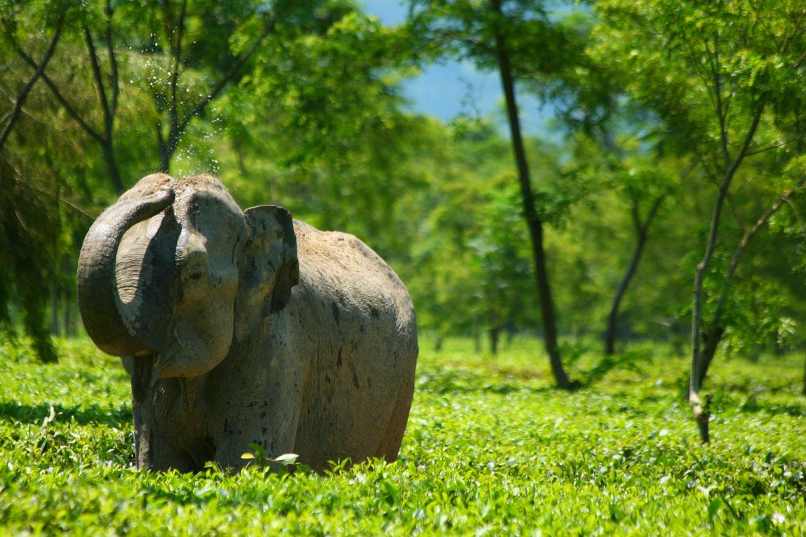Protected Areas Vulnerable to Growing Emphasis on Food Security
New study shows croplands are prevalent in protected areas, challenging their efficacy in meeting conservation goals.
For release: January 19, 2021
Contact: vvijay@sesync.org

Image courtesy of Sashanka Barbaruah-Wildlife Trust of India
ANNAPOLIS, Md – Protected areas are critical to mitigating extinction of species; however, they may also be in conflict with efforts to feed the growing human population. A new study shows that 6% of all global terrestrial protected areas are already made up of cropland, a heavily modified habitat that is often not suitable for supporting wildlife. Worse, 22% of this cropland occurs in areas supposedly enjoying the strictest levels of protection, the keystone of global biodiversity protection efforts.
This finding was published in the Proceedings of the National Academy of Sciences by researchers at the University of Maryland’s National Socio-Environmental Synthesis Center (SESYNC) and National Institute for Mathematical and Biological Synthesis (NIMBioS) at the University of Tennessee. In order to comprehensively examine global cropland impacts in protected areas for the first time, the authors synthesized a number of remotely sensed cropland estimates and diverse socio-environmental datasets.
The persistence of many native species—particularly habitat specialists (species that depend on a narrow set of natural systems), rare, and threatened species—is incompatible with conversion of habitat to cropland, thus compromising the primary conservation goal of these protected areas. Guided by the needs of conservation end users, the researchers used methods that provide an important benchmark and reproducible methods for rapid monitoring of cropland in protected areas.
“Combining multiple remote sensing approaches with ongoing inventory and survey work will allow us to better understand the impacts of conversion on different taxa,” says lead author Varsha Vijay, a conservation scientist who was a postdoctoral fellow at SESYNC while working on the study. “Cropland in biodiversity hotspots warrant particularly careful monitoring. In many of these regions, expanding cropland to meet increasing food demand exposes species to both habitat loss and increased human-wildlife conflict,” she adds.
Countries with higher population density, lower income inequality, and higher agricultural suitability tend to have more cropland in their protected areas. Even though cropland in protected areas is most dominant in mid-northern latitudes, the tradeoffs between biodiversity and food security may be most acute in the tropics and subtropics. This increased tradeoff is due to higher levels of species richness coinciding with a high proportion of cropland-impacted protected areas.
“The findings of this study emphasize the need to move beyond area-based conservation targets and develop quantitative measures to improve conservation outcomes in protected areas, especially in areas of high food insecurity and biodiversity” says Lucas Joppa, chief environmental officer of Microsoft, who has published numerous papers on the topic of protected area effectiveness but who was not an author on the study.
2021 is a historic “Year of Impact,” when many countries and international agencies are developing new decadal targets for biodiversity conservation and protected areas. As countries aim to meet these goals and the 2030 Sustainable Development Goals, there is an increasing need to understand synergies and tradeoffs between these goals in order to ensure a more sustainable future. Studies such as these offer insights for protected area planning and management, particularly as future protected areas expand into an agriculturally dominated matrix. Though the study reveals many challenges for the future, it also reveals potential scenarios for restoration in mid-northern latitudes and for cooperation between conservation and food programs in regions with both high levels of food insecurity and biodiversity.
“Despite clear connections between food production and biodiversity, conservation and development planning are still often treated as independent processes,” says study co-author Paul Armsworth from the University of Tennessee. “Rapid advances in data availability provide exciting opportunities for bringing the two processes together,” adds Vijay.
###
The paper, “Pervasive cropland in protected areas highlight trade-offs between conservation and food security,” Varsha Vijay and Paul Armsworth, appears in the Proceedings of the National Academy of Sciences. doi:10.1073/pnas.2010121118
https://www.pnas.org/content/118/4/e2010121118
The study is based upon work funded by the National Science Foundation (Award No.: DBI-1639145).
Contact: Varsha Vijay, 319-321-8459, vvijay@sesync.org